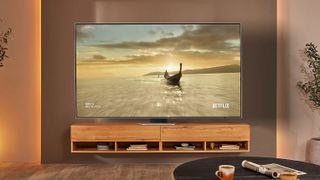In our Samsung QN85B review, we pointed out that this Neo QLED TV isn’t shy about making you put the hard yards in before you get the sort of picture quality that matches your expectations (and your outlay) when buying one of the best Samsung TVs.
Happily, it’s possible to tweak the picture settings for each input rather than as a ‘one size fits all’ solution for every input and every source, which is ideal. After all, we all know that a Playstation 5 has a rather different picture quality emphasis to a 4K Blu-ray player, which is different again from an Amazon Fire TV Stick 4K Max streaming stick.
We can't take you through the ideal settings for every possible input, but here are the key settings that will help to get the best picture quality from the QN85B, based on our experience reviewing it.

1. Use the best motion setting
In every circumstance, it’s important to switch the ‘LED Clear Motion’ option to ‘on’. Yes, when you first do it you’ll be aghast at how it carves into the screen’s peak brightness – but it allows the Samsung to keep a stern grip of on-screen motion. Leave it off and you’ll have to reconcile brilliantly bright images with smeary and uncertain on-screen movement from even the highest-quality sources.
2. Reduce grain reduction
Every source (except very low-res sources) will benefit from knocking the noise-reduction settings ‘off’, too. Yes, the resulting images will carry a touch more grain – but they’ll also look more natural and less processed. Some images are supposed to have grain.
3. Don't use Filmmaker Mode
The Samsung features ‘Filmmaker Mode’, and here (as everywhere else) it claims to deliver content more closely to the filmmaker’s intention than would otherwise be possible. But while ‘Filmmaker Mode’ disables almost all of the TV’s flashier processing options (which is usually a good idea) it also does the common ‘Filmmaker Mode’ thing of reducing brightness until images are frankly dull.
So unless you want an idea of what it’s like to have cataracts (and to negate one of Mini-LED's selling points at the same time), it’s best avoided, especially if you watch in a bright room.
4. Don't do the 'Smart Calibration'
The QN85B supports Samsung’s new ‘Smart Calibration’ feature. If your iOS smartphone supports Face ID, or if you have one of quite a long list of Galaxy S, Flip or Note smartphones, you can use this feature to calibrate the TV automatically.
Its effect is negligible in our experience, though – and it rather bloody-mindedly locks in its settings, meaning you’d need to do a full reset of the TV to alter the settings again. For this reason, we recommend avoiding it.
There's more tinkering you can do to Samsung TVs that's non-specific to the QN85B – check our guide to tips for getting the most from any Samsung TV for general advice!

